

 The Accurate Reloading Forums
The Accurate Reloading Forums  THE ACCURATE RELOADING.COM FORUMS
THE ACCURATE RELOADING.COM FORUMS  Rifles
Rifles  Big Bores
Big Bores  Article on the Evergreen 375 H&H
Article on the Evergreen 375 H&HGo  | New  | Find  | Notify  | Tools  | Reply  |  |
| one of us |
This is my latest little article. Please feel free to correct any historical mistakes. Corrected for grammar, spelling, content, etc. 2nd Draft below  | ||
|
| one of us |
THIRD DRAFT LAWNDART’S RELOADING ROOM, #14; HOLLAND & HOLLAND’S 375 BELTED RIMLESS MAGNUM EXPRESS The above (and original) moniker of the 375 H&H practically commands you to buy a Holland & Holland rifle in the quintessential British medium bore of the modern Nitro Express era. That era, by the way, is fast closing in on 120 years. Before delving into the nuts and bolts of the 375, let us take a few moments to review the history of what has often been called “the world’s best all around rifle, ever made.” A review of the 375 Holland & Holland consists mainly of burying some long perpetrated, but incorrect, beliefs that have been passed down from gun scribe to gun writer since 1912. The 375 Holland & Holland was not the first cartridge to be adorned with a circumferential belt just forward of the extraction groove. That honor goes to the 400/375 Belted Nitro Express. The 400/375 is wimpy by today’s standards. It is very similar to the 9.5 x 56 Mannlicher Schöenauer (called the 375, 2 ¼” Nitro Express on the English side of the channel). The 400/375 predates the Mannlicher Schöenauer round by five years. Both are close to the modern 358 Winchester. The Winchester 358 in turn, has modest power suitable for medium game. With judicious bullet placement it can take down an elk at close range. The 375 H&H is not loaded with Cordite. The British ammunition manufacturing corporation Kynoch last used cordite in the early to mid 1960s. In its time, cordite (which resembled strings of spaghetti) was cut to length and inserted into the partly formed cartridge case. The case neck was then formed, and a bullet was seated. Prior to WWI, Cordite was somewhat unstable in conditions of high heat and humidity. Ammunition intended for use in Africa or India was loaded with 58-grains of propellant; that intended for use in more temperate climes was loaded with 60-grains. As a consequence of using Cordite as a propellant, the 375 H&H cartridge case had a very shallow neck angle (14.96º). There was not adequate assurance that reliable head spacing would be achieved on the sloping cartridge shoulder. Ammunition engineers of the day defaulted to the least accurate, but perfectly reliable, and necessary, form of head spacing. This involved placing a “belt” around the case circumference just distal to the extraction groove. It was not pretty, but it got the job done. Later, this belt became a marketing tool to sell medium length magnum rifles from the 1940s, 50s, and 60s. There is even nonsense circulating about the word “Magnum” itself. It does not derive from the French word describing an extra large bottle of wine, especially Champagne. The truth is much less romantic. “Magnum” is derived from the Latin word Magnus meaning large or great. Calling a 2x sized bottle of champagne a “Magnum” is a special use of the word, not the word itself. The 375 H&H was introduced in 1912, is 102 years old, and will likely continue to perform yeoman’s duty for another hundred years or so. At least we do not have to argue about the date on its birth certificate. As the POMMIES (Prisoners of Mother England) would say, the 375 H&H design is “absolutely brilliant”. They will get no argument from me. My mom taught me to not stand on the railroad tracks of history, design, or purpose. The continuing success of the 375 H&H rests on three legs. One, with modern “super” bullets, it will kill any animal on earth with one well placed shot. Two, it is the most powerful cartridge for which an average hunter can more easily master the recoil. There is no need for a muzzle brake or an excessively heavy rifle. Third, anywhere there is hunting, 375 H&H ammunition can be purchased across the counter most any hardware store, shooting emporium, or even drugstore. OK, enough of history - let us get into the fun stuff. Useful bullet weights vary from 235-grains on the light end, to 300-grains on the top end. 350-grain and 380-grain bullets in .375 diameter are for rather specialized applications. Super bullet technology has come to full bloom in the 300-grain weight projectiles. Bullet types run the gamut from simple cup and core, bonded core, monometal of copper, brass, or naval bronze, partitioned designs like, well the Nosler Partition, partition plus bonding as exemplified by the Swift A-Frame bullet, the gone, but still lamented Fail-Safe design that Nosler made for Winchester in the 1990s. In addition to monometal designs, there are still many classic designs for solid bullets that are characterized by a lead core with a thick steel covering and finally a very thick copper covering that allows the rifle’s lands and grooves to do their magic without damage to the barrel. Powder types in use cover the water front from ball/spherical numbers, to fine grained extruded examples and even large Lincoln Log extruded powders in the back ground and ever ready to step into the breach. Good examples of ball powders are the identical Hodgdon H-414/Winchester 760. The IMR 4064 powder is a medium burning rate Lincoln log powder with a history of great accuracy and utility. The archetypical fine extruded powder is the Norma N 203B. A looser tolerance version of the same powder has been marketed for many years in the USA as Reloder 15, first under the Hercules banner and more lately as a member of the Alliant Tech Systems conglomerate. IMR 4759 consists of large, bulky, gray flakes which make it ideal for creating low velocity training loads. H4350 is a slower extruded powder that often works well with 300 grain projectiles. Hodgdon H4895 has utility in crafting training loads. So, the brats are out of college. You have a little extra money tucked under the mattress. Your knees are shot, so a sheep hunt will have to wait until your next life. You visit the Dallas Safari Club show in the dark months of winter and end up booking ten days of plains game hunting in Namibia, followed by another ten day x two Buffalo hunt in Zimbabwe. The hunt is eighteen months away; you are filled with 50% excitement and 50% trepidation. A 300 Win Mag feels rough in the recoil department to you. How can you handle a 375 H&H at all, let alone quickly and instantly accurately? Relax! Bring your favorite 30-06 for plains game, and start working out and working up with the 375. Buy a quality 375 H&H rifle that fits you well, or can be made to fit you. If you have a long neck, you will need a rifle with a decent sized Monte Carlo on the butt stock; style be dammed. If you are built like a fireplug, or just have a short neck, you will be best served with a butt stock in the straight back American Classic style. Make sure the stock is wood. Wood can be bent in place, rasped away; more wood can be splinted in where needed. Wood is the most flexible material to use to make a well fitted stock. Then, take it to a gunsmith who specializes in making shotguns and rifles fit gunning clients. You want your rifle to fit so well that it is an extension of your will. It can be done. If you are built like me (17.5” neck size, 34.5” sleeves, but with a long neck), the stock fitter will bend the stock to give you 5/16” of cast off (away from right hander), ¼” of toe out at the butt, and carve out or add on a Monte Carlo. The dimensions are similar to the Sako Hunter style stock that McMillan makes for Ruger, Remington, Sako AV style, Browning, and Winchester stocks. So, a long necked dude can save some money right there on the all-important topic of stock fit. The gunsmith will make your wooden stock fit you, no matter what your build. Fit it must; if you want to hit your targets that is. It does no good to be afraid of the recoil or muzzle blast of any rifle, but especially one that you will be carrying in the presence of dangerous game. Good fit is half the battle. The other half is following a training and conditioning program. A good first step is to start practicing with lightweight bullets at mild velocities. A near perfect starting bullet is the Speer .375”, 235-grain, Semi-Spitzer Soft Point. Use a large rifle magnum primer and load the 235-grain Speer over 29.0-grains of IMR SR 4759. Since this powder is composed of large and flaky individual particles, it is best to weigh each load. Your velocity will be ≈ 1650 fps. That is light and very controllable. It is also a reasonably accurate load. Zero it at 50-75 yards. As soon as you have a well regulated (well centered) group, get away from the bench in favor of field positions (in the future you will only visit the bench to obtain an initial zero, or to evaluate the precision [smallness and roundness] of any given load). Start practicing from the sitting position with legs not crossed, and then crossed with right ankle on top, then with left ankle on top. Shoot five shot groups. Those force you to concentrate on the fundamentals of marksmanship and follow through. Twenty to twenty-five rounds down range should be the maximum shooting for any range session. It is ok to warm up ahead of time with a .22 LR, using the same positions. On your second visit to the range, shoot the same load. Start with one set of sitting position shooting, and then transit to shooting kneeling. Use a tree or a bench for extra support for your first kneeling group; then transition to shooting kneeling without extra support, just your bones (and knee and elbow pads). Finish up your second session with one group shot from the standing position. A coach to supervise your progress is indeed priceless. On your third session, start out with one group sitting, one group kneeling, and all remaining groups standing. For your last group of the session, have your shooting coach hold a set of three African shooting sticks, Adjust them until they feel just right, and send the last five bullets down range. On your fourth range session, you will be still using Speer 235-grain Semi-Spitzer bullets, but there will be some simple math involved in figuring the charge weight. For moderately reduced loads, Hodgdon offers the 60% rule. Take the maximum charge listed for Hodgdon H4895 powder, and multiply it by 60%. For example, The Hodgdon® 2014 Annual Manual of Reloading lists a maximum charge of H4895 for the Speer 235-grain Semi-Spitzer as being 74.0-grains. 60% of 74.0 = 44.4-grains. Zero this load at a full 100 yards. Shoot one group sitting, one kneeling, one standing unsupported, and at least two groups supported by shooting sticks. Spend two range sessions shooting the 60% rule loads. Then, go through both the Speer and Hodgdon manuals, and pick a starting load of Varget™ for the 235-grain Semi Spitzer. Zero from the bench at exactly 200 yards. The load velocity will be a bit over 2,700 fps. This is a nearly full-power deer and elk load (for moderate ranges). Do two new range sessions just like the last two, with one addition; shoot at an 8” paper plate set out at 200 yards for your last group which will be done standing while supported by the shooting sticks. Next pick up some 250 grain bullets such as the Sierra® .375” Game King Spitzer Boat Tail. Start shooting the 60% Hodgdon rule based on a maximum load of 69-grains (41.4-grains). After two sessions, go up to a starting load of either Reloder 15/Norma N 203B or Hodgdon H414/ Winchester 760 and do two more range sessions. Then, repeat for two more sessions with a full power load of your chosen powder. On your drills, make sure at least two are supported shooting off shooting sticks. A 260-grain bullet, such as the Nosler® Accubond™ will work just as well. Ok, we are coming around the final bend. Try any one of the excellent 270-grain plains game bullets on the market. The Hornady 275-grain is a dandy, as is the Speer 270-grain Spitzer Boat Tail Soft Point. Use both starting, and full power loads with your choice of H4350, Reloder-15, H414, or Varget; concentrate your drills on shooting at the 200 yard target from the sticks. Also, practice holding the sticks yourself as you shoot. Wow, we are now up to the 300-grain level. Pick a (relatively) inexpensive 300-grain bullet such as the Nosler 300-grain Accubond or the Sierra 300-grain Game King™ Spitzer Boat Tail. Practice shooting at 25 yards, 100 yards and 200 yards, with emphasis on shooting off the sticks. Finally, spend some time obsessing over what is the best 300-grain bullet for your hunt. I use North Fork softs and solids exclusively these days, but pick bullets that you have trust in. Talk to PHs, and people who have at least two full hunts under their belt. Whatever ammunition you take hunting, cycle each and every round through your rifle before you go. In the middle of a charge is not the time to discover that your cartridges are hanging up! This program takes a while, but it costs only a small fraction of the overall time and money involved in a full on ten day buffalo hunt. For a moderate expenditure of your time and energy, you will be able to confidently drill your shots at all ranges and from all field shooting positions. You will not need a muzzle brake as a crutch. Your Professional Hunter will love you for that alone. Go out, practice sensibly (let your rifle’s bore cool between groups), and then enjoy a buffalo hunt with no drama, just satisfaction of a job done better than well.  | |||
|
| one of us |
Lawndart, Neat pot o'history, and good advice on loading and training with the undeniable champion cartridge for the "do-all-with-the-least-fuss" rifle. Review emphasis of a few of my favorite points about the "Evergreen .375 H&H": A. The belt is obviously not such a bad thing for head-spacing. It is positively functional for that, with .375 H&H overall case shape making it a slick feeder, positively. B. The .375 H&H is powerful enough to serve all big bame purposes with the right bullet. C. The .375 H&H is a joy to carry and shoot in a 6.75# featherweight, or slightly heavier sporter. D. One needs to acquire no more rifles after purchase of his first .375 H&H. E. There is no fun in "D." However, for patriotic posterity, they just perfected it. From an old thread here: ************************************************ ... for .400/.375 Belted Nitro Express aka .400/.375 H&H aka .400/.375 Express aka .400/.375 Velopex. If the velocity was around 2500 fps, it (original "Velopex" light bullet loaded) must have been a light one, probably around 230 grains or less, eh? Standard load was 43 grains of cordite and a 270-grain bullet, velocity 2175 fps. There was a 320-grain load also with 43 grains of cordite estimated at 2000 fps. Henry W. Holland wrote the application for patent on the belted case on Dec. 19, 1904, accepted January 26, 1905. However, remember the Roper Revolving Rifles and Shotguns of 1866 patent, from Hartford, Connecticut, USA? The .41 Roper rifle cartridge had a one-piece steel case with a belt, and a screwed-in percussion nipple to accept percussion caps as primers. Subsequently it had regular recess in base for standard priming. It was such a stout case, it was more like an accessory chamber, and the revolving rifle held 6 of these reloadable cases in its cylinder. .41 Roper, the first belted cartridge case, 1866 USA, made of steel:  NRA National Firearms Museum specimen of a Roper revolving shotgun, 4-shooter, rifle was 6-shooter, similarly: http://www.youtube.com/watch?v=66CS7ffaeuM Never a Blaser Shooter, Rip Riflecrank Internationale Permanente, DRSS, SSSS, BASS, LASS, SLSS ****************************************************** Self Appointed Poobah of C.R.I.P. | |||
|
| One of Us |
Lawndart? Ever used to drive an F-16? My time stopped with T-33s. Good 375 article. I've got its new cousin - 375 Ruger. | |||
|
| one of us |
RIP the Roper? That is way cool to know. I may add a blurb about weight being ideal for the masses at 8 to 8 1/2#, unloaded. I have to mention ideal scope numbers. Those may go into a future article on preparing your rifle for the hunt. Poprivit, Guilty as charged. I started with the F-4 (Hard Wing "D" model), and then transitioned to the F-16 "Viper"(the ultimate love of my life!). All fighter jocks are doomed to see their once mighty and modern steed become an historical foot note (and see it used as a drone out of Tyndal AFB, Florida) I really like the Ruger take on .375". I may have to neck one down to 9.3 mm (The 9.3 Newton, 'eh?) Thank you both for the feed back.  | |||
|
| one of us |
Third Paragraph, 6th line down, about 3/4ths of the way to the right, typo. Should read "of head spacing" or "for head spacing." Comments: A belt is a perfectly reliable way to ensure proper head spacing. Might want to mention the potential feeding issues with other than RN or pointy bullets, like your favorite NF FN solids, and that a prospective DG hunter ought to cycle every round he is bringing with him intended for DG through his rifle a couple of times to ensure magazine fit, feeding and chambering for when he might NEED a round to come out of the magazine and into the chamber without any issues of hangups. Good read, JPK  Free 500grains Free 500grains | |||
|
| One of Us |
Enjoyed it! My mind has a tendency to "look ahead" of what I'm reading, and when I came to the sentence about the recoil of the .300 Win Mag, I subconsciously "knew" you would relate the difference in the felt recoil between the .300 and the .375. But it didn't come. I can endure the "push" of 300 grain .375s all day, but the sharp recoil of the .300 WM turns me into a recoil shy neophyte. But maybe my experience is unique. Love your writing style! | |||
|
| one of us |
I liken big bore recoil to getting shoved over by a linebacker (in slow motion). The 300 Win Mag is like getting hit at high speed with a baseball bat that you did not see coming. That sensation is likely common to all over bore cartridges. I have not tried them all, so I cannot say for sure. Thanks for the typo pickup JPK. I will insert your suggestions as well; they are appreciated.  | |||
|
| One of Us |
Thanks for the article, I enjoyed it very much. Roger ___________________________ I'm a trophy hunter - until something better comes along. *we band of 45-70ers* | |||
|
| One of Us |
Something that I've wondered about is the 400/375 Belted Nitro Express. With the British method of naming the parent case first, then the caliber of off-spring, doesn't that seem to imply that there should have been a .400 Belted Nitro Express? | |||
|
| one of us |
But there was not. There also should have been a straight-cased, flanged .400 Nitro Express with heavy bullets, but there was not. 1905: It appears there was a flurry of activity surrounding the old rimmed/flanged "400" black powder cartridge case. In lengths from 2-3/8" to 3-1/2", it had been used with .395-caliber bullets since the 1870s or thereabouts, in single shots and doubles, Martini-Henry rifle, etc. From an early COTW, 6th Ed. 1989, the last year to show this: 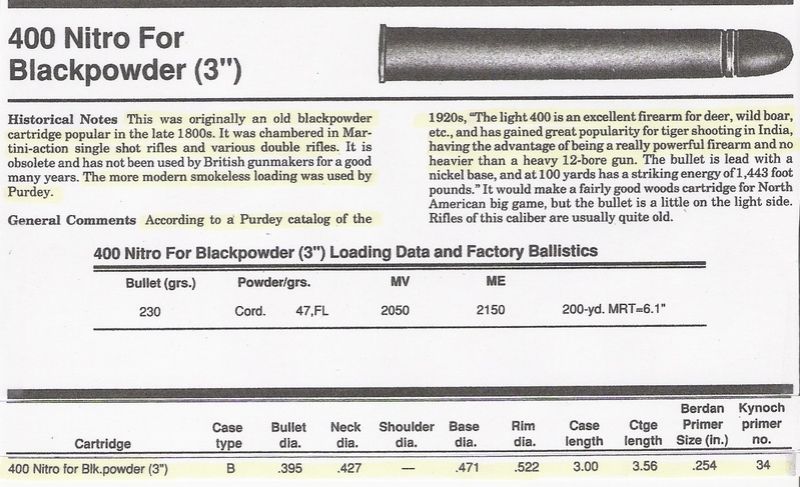 Fred A. Datig shows this, measurements from a single battered old specimen with soft lead exposed bullet: Cartridges for Collectors Volume 1 (Centerfire)  Purdey adopted it for the .400 Purdey with 3-inch case and .405-caliber, 230-grain bullets: Nitro for BPE, Light Rifle Express, etc. 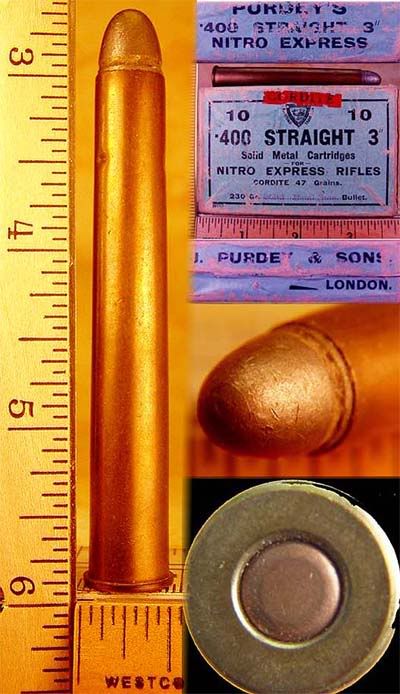 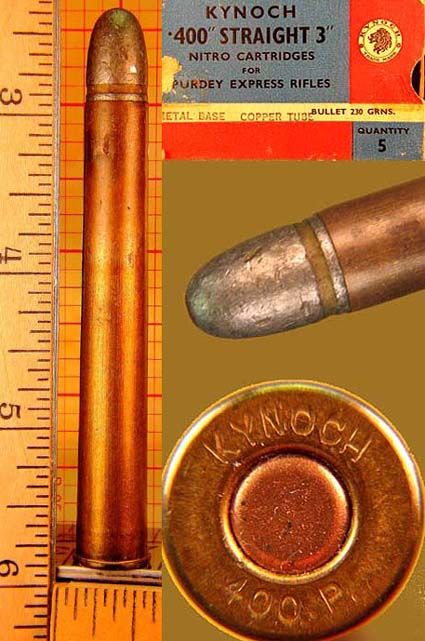  Subsequent to the 6th Ed. of COTW, the 400 Nitro for BP 3" disappeared, replaced by the 400 Purdey. As you were, 1905: Then H&H took that old case and in one fell swoop necked it down to .375, shortened it, belted it (copied from the .41 Roper case of the 1870s), put an extractor groove on it, and and made it rimless. Fred A. Datig again:  George A. Hoyem: 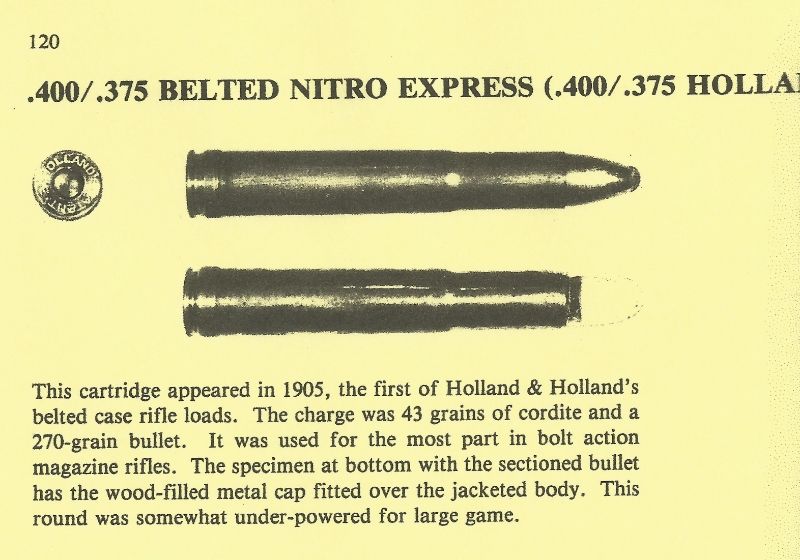 That is how I see it. We all owe a debt of gratitude to the .395-caliber cartridge that gave up it's rightful progression to 400/.395 Nitro Express 3-Inch, so that the .375 H&H might be born in 1912 from its mutations. Subsequent early 1900s British wildcatting shown by George A. Hoyem: History and Development of Small Arms Ammunition Volume Three (British Sporting Rifle Cartridges) 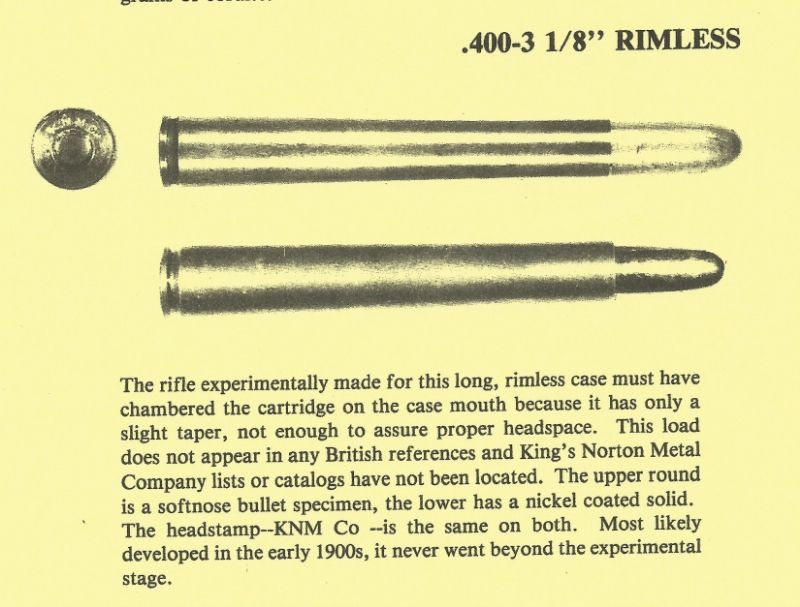 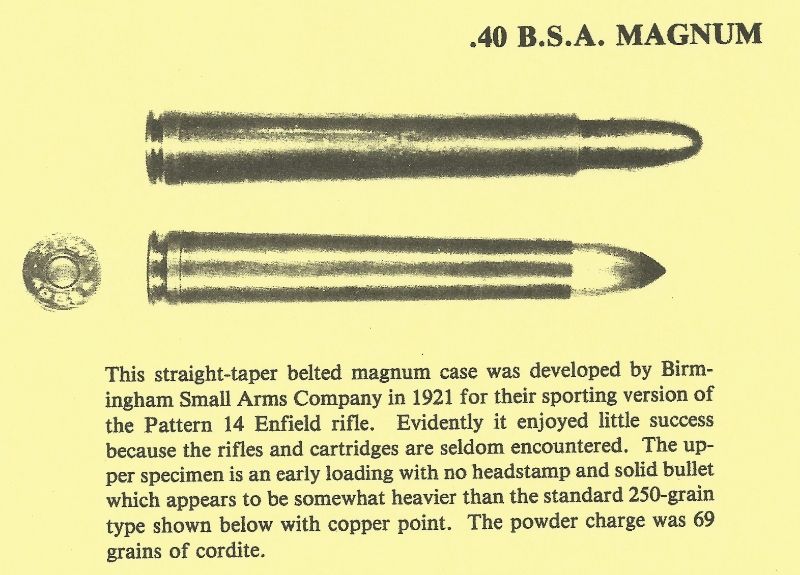 | |||
|
| Powered by Social Strata |
| Please Wait. Your request is being processed... |
|
 The Accurate Reloading Forums
The Accurate Reloading Forums  THE ACCURATE RELOADING.COM FORUMS
THE ACCURATE RELOADING.COM FORUMS  Rifles
Rifles  Big Bores
Big Bores  Article on the Evergreen 375 H&H
Article on the Evergreen 375 H&H

Visit our on-line store for AR Memorabilia

